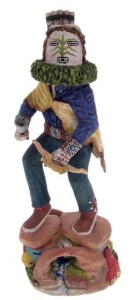Have you ever wondered what those beautifully carved dolls with the masked faces were really called? They are known as kachinas. Navajo kachinas are some of the most beautiful available.
The Navajo kachinas really have no religious meaning to the Navajos. The Hopi’s and other Native Americans placed great spiritual value on the kachinas, but the Navajo kachinas are more a source of income than a religious symbol.
History of Navajo Kachinas
Pueblo kachinas were the original dolls and Hopi kachinas were carved of cottonwood roots. Navajo kachinas are produced with harder woods, the pieces are mass produced and hand-painted, adorned with beautiful outfits often made with rabbit fur, beads and feathers and elaborate masks. Called ‘Tasapkachina’ the Navajo kachinas are highly collectible.
Kachinas were originally thought to be spirits who worked among the tribes to teach life skills. The dolls were used to teach Native American children about the beliefs of the tribe. The Navajo kachinas have been fashioned after the Hopi kachinas and many carry specific functions in the ceremonial dances.
For instance, the Eagle Dancer is one of the most popular of the Navajo kachinas. It is considered a great honor for the Eagle Dancer to show up. His function is to imitate the flight of the eagle in his dance. Navajo kachinas such as Mastop kachinas are believed to bring fertility to all the females. There are also animal kachinas, such as the deer which is believed to bring the rains.
Navajo kachinas are highly collectible. Navajo kachinas such as the eagle with the beautiful spread feathers, the colorful clown, the wolf with his fierce face, the chief with his impressive headdress, and the butterfly kachina are the most popular with serious collectors having at least one.
If you are thinking of starting a Navajo kachinas collection remember that real bird feathers are illegal. Feathers will now be carved of wood. Also, collect what you love. There are so many beautiful Navajo kachinas to choose from. Choose the Navajo kachinas that fit your style.
Many carvers choose old-style, some even using natural pigment paints. Others choose more modern sculptural style. And prices can range from six figure pre-1920’s dolls to the more affordable 1960’s and 1970’s Navajo kachinas starting at around 200 dollars.
Most importantly, enjoy the Navajo kachinas for the culture they represent. Cheaper Navajo kachinas are culturally collectible, even if they are not considered museum quality pieces.
